Lecture Materials
Basic methods#
Consider a generic problem of integrating a function over some interval:
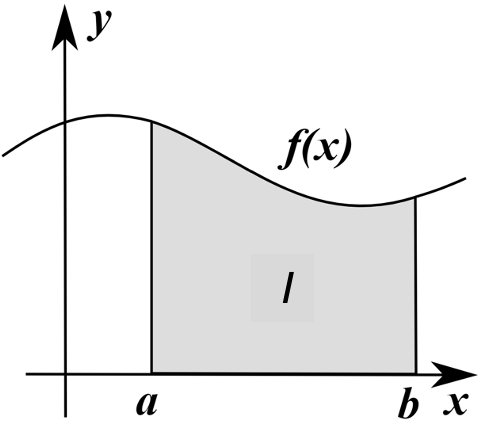
We may need to resort to numerical integration when:
we have no explicit expression for \(f(x)\) but only know its values at certain points
we do not know how to evaluate the antiderivative of \(f(x)\) even if we know \(f(x)\) itself
There are two main types of numerical integration methods:
direct evaluation of the integral over the interval (a,b)
composite methods where the integration interval is separated into sub-intervals
The most common methods are:
Rectangle, trapezoidal and Simpson rules
Quadratures (Newton-Cotes, Gaussian)
Adaptive quadratures: divide the integration range into subintervals to control the error
The basic methods make use of interpretation of the integral as an area under the curve and approximating this area by simple shapes (rectangles, trapezoids, etc.).
Rectangle rule#
Basic rectangle rule#
Approximate the integral by an area of a rectangle:
Composite rectangle rule#
To improve the accuracy, separate the integration interval into \(N\) subintervals of length \(h = (b-a)/N\) and apply the rectangle rule to each of them. This leads to the so-called composite (extended) rectangle rule:
with
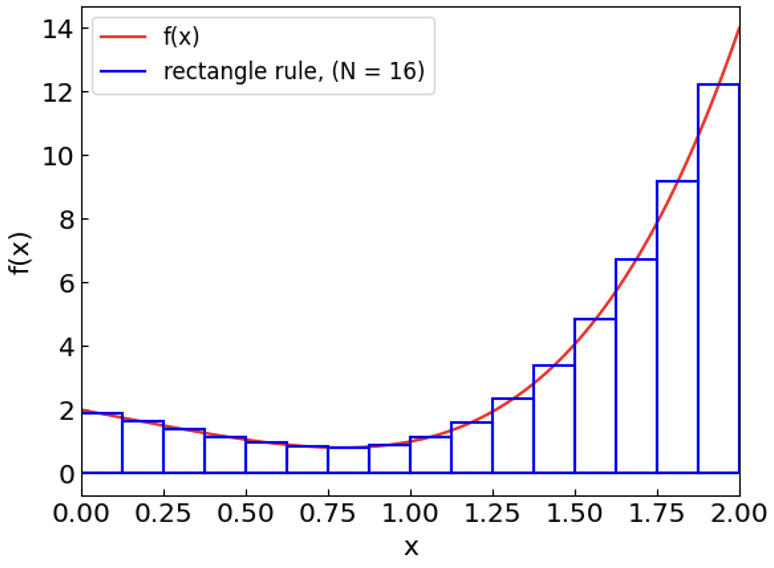
Implementation#
# Rectangle rule for numerical integration
# of function f(x) over (a,b) using n subintervals
def rectangle_rule(f, a, b, n):
h = (b - a) / n
ret = 0.0
xk = a + h / 2.
for k in range(n):
ret += f(xk) * h
xk += h
return ret
Consider a function \(f(x) = x^4 - 2x + 2\) and its integral over \((0,2)\). We can compute the exact value of the integral analytically:
We can use this function to test the accuracy of the numerical integration methods.
# The function example we will use
# Overwrite as applicable
flabel = 'x^4 - 2x + 2'
def f(x):
return x**4 - 2*x + 2
flimit_a = 0.
flimit_b = 2.
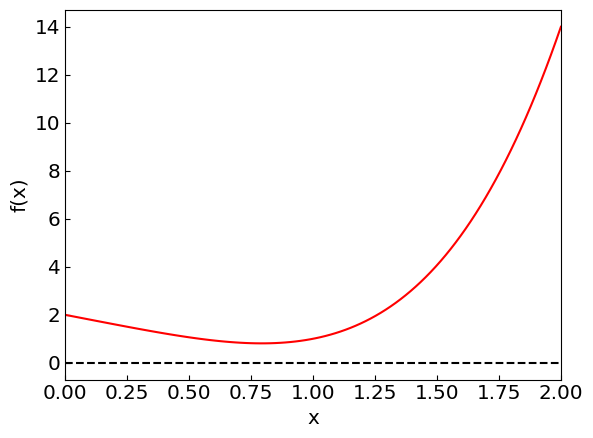
Illustration#
Let us evaluate the performance of numerical integration
a = flimit_a
b = flimit_b
print("Computing the integral of",flabel, "over the interval (",a,",",b,") using rectangle rule")
for n in range(1,31):
print("N =",n,", I = ",rectangle_rule(f,a,b,n))
rectangle_rule_plot(f,a,b,5).show()
rectangle_rule_plot(f,a,b,10).show()
rectangle_rule_plot(f,a,b,30).show()
Computing the integral of x^4 - 2x + 2 over the interval ( 0.0 , 2.0 ) using rectangle rule
N = 1 , I = 2.0
N = 2 , I = 5.125
N = 3 , I = 5.818930041152262
N = 4 , I = 6.0703125
N = 5 , I = 6.188159999999999
N = 6 , I = 6.252572016460903
N = 7 , I = 6.291545189504369
N = 8 , I = 6.31689453125
N = 9 , I = 6.334298633338417
N = 10 , I = 6.346759999999996
N = 11 , I = 6.355986612936278
N = 12 , I = 6.363007973251031
N = 13 , I = 6.368474493190009
N = 14 , I = 6.37281341107871
N = 15 , I = 6.376314732510287
N = 16 , I = 6.379180908203125
N = 17 , I = 6.381556734234506
N = 18 , I = 6.383547985571311
N = 19 , I = 6.385233385256395
N = 20 , I = 6.386672500000006
N = 21 , I = 6.387911072718333
N = 22 , I = 6.388984700498595
N = 23 , I = 6.3899214196633
N = 24 , I = 6.3907435538837385
N = 25 , I = 6.391469056000005
N = 26 , I = 6.392112496061053
N = 27 , I = 6.392685798298071
N = 28 , I = 6.393198797376085
N = 29 , I = 6.393659662849694
N = 30 , I = 6.394075226337445
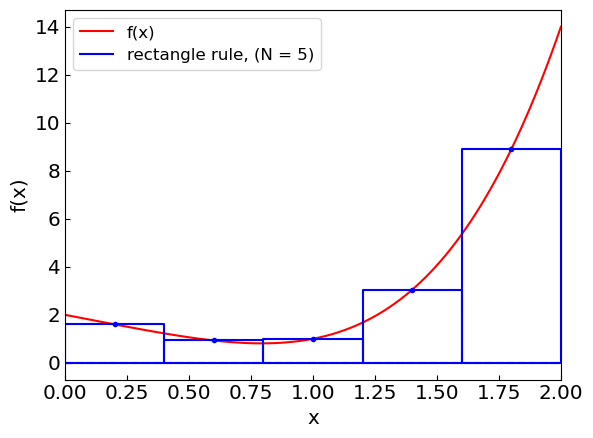
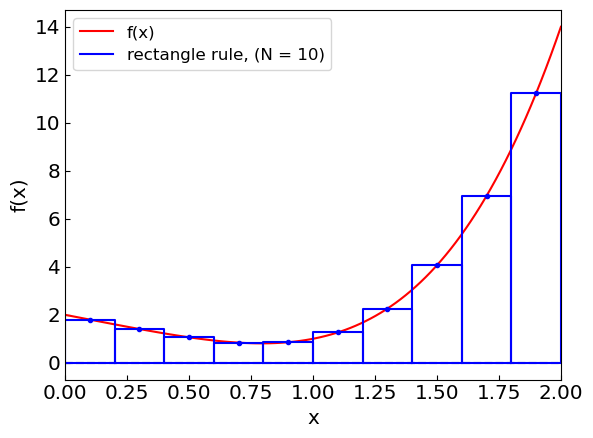
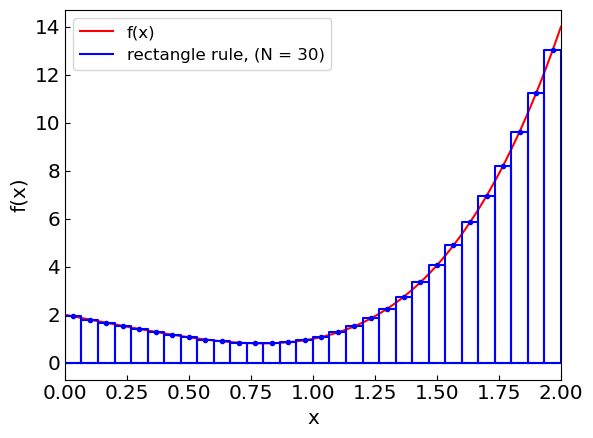
Let us illustrate the composite rectangle rule approximation as we increase the number of subintervals.
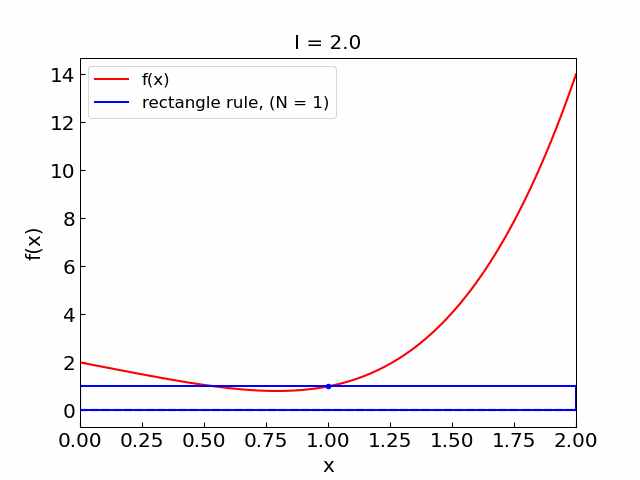
Error#
The error for a rectangle rule can be shown to be equal to (using the Taylor theorem):
to leading order in \((b-a)\).
For the composite rectangle rule, we have this rule for each subinterval \(h = (b-a) / N\) and we have to sum up the errors from each interval. We have
The rectangle rule is exact (up to round-off errors) for the integration of linear functions (\(f'' = 0\) and all higher-order derivatives).
flabellinear = 'f(x) = 2*x + 3'
def flinear(x):
return 2. * x + 3.
a = 0.
b = 2.
for n in range(1,6):
print("N =",n,", I = ",rectangle_rule(flinear,a,b,n))
N = 1 , I = 10.0
N = 2 , I = 10.0
N = 3 , I = 9.999999999999998
N = 4 , I = 10.0
N = 5 , I = 10.0
Trapezoidal rule#
Basic trapezoidal rule#
Approximate the integral by an area of a trapezoid. This is achieved by linear interpolation of the function between (sub)interval endpoints:
Composite trapezoidal rule#
As for rectangle rule, to improve the accuracy, separate the integration interval into \(N\) subintervals of length \(h = (b-a)/N\) and apply the trapezoidal rule to each of them
with
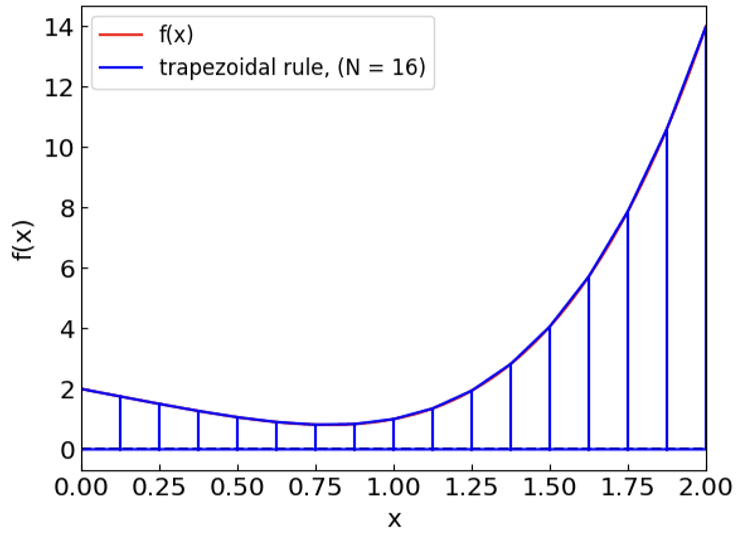
Implementation#
# Trapezoidal rule for numerical integration
# of function f(x) over (a,b) using n subintervals
def trapezoidal_rule(f, a, b, n):
h = (b - a) / n
ret = 0.0
xk = a
fk = f(xk)
for k in range(n):
xk += h
fk1 = f(xk)
ret += h * (fk + fk1) / 2.
fk = fk1
return ret
Illustration#
Let us test the method on our function \(f(x) = x^4 - 2x + 2\) over the interval \((0,2)\).
a = flimit_a
b = flimit_b
print("Computing the integral of",flabel, "over the interval (",a,",",b,") using trapezoidal rule")
for n in range(1,31):
print("N =",n,", I = ",trapezoidal_rule(f,a,b,n))
Computing the integral of x^4 - 2x + 2 over the interval ( 0.0 , 2.0 ) using trapezoidal rule
N = 1 , I = 16.0
N = 2 , I = 9.0
N = 3 , I = 7.572016460905349
N = 4 , I = 7.0625
N = 5 , I = 6.824960000000001
N = 6 , I = 6.695473251028805
N = 7 , I = 6.61724281549354
N = 8 , I = 6.56640625
N = 9 , I = 6.531524665955397
N = 10 , I = 6.506559999999999
N = 11 , I = 6.488081415203885
N = 12 , I = 6.474022633744856
N = 13 , I = 6.463079023843701
N = 14 , I = 6.454394002498951
N = 15 , I = 6.447386337448559
N = 16 , I = 6.441650390625
N = 17 , I = 6.4368961099603705
N = 18 , I = 6.432911649646909
N = 19 , I = 6.429539368175497
N = 20 , I = 6.426660000000005
N = 21 , I = 6.424181968075723
N = 22 , I = 6.422034014070073
N = 23 , I = 6.420160019439603
N = 24 , I = 6.418515303497934
N = 25 , I = 6.417063936000004
N = 26 , I = 6.41577675851685
N = 27 , I = 6.4146299087449545
N = 28 , I = 6.41360370678883
N = 29 , I = 6.412681805392758
N = 30 , I = 6.411850534979421
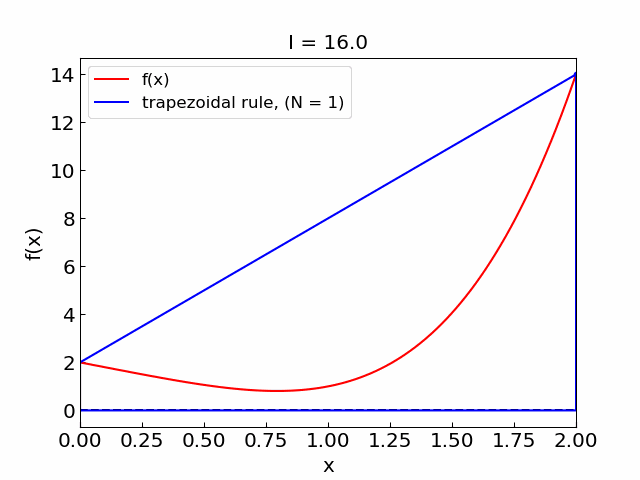
Error#
The error for the trapezoidal rule can be shown to be equal to (using the Taylor theorem): $\( I - I_{\rm trap} = \int_a^b f(x) dx ~~ - ~~ (b-a) \, \frac{f(a) + f(b)}{2} \approx -\frac{(b-a)^3}{12} f''(a) \)\( to leading order in \)(b-a)$.
For the composite trapezoidal rule we have: $\( I - I_{\rm trap} = -(b-a) \frac{h^2}{12} \, f''(a) + \mathcal{O}(h^4). \)$
Just like the rectangle rule, the trapezoidal rule is exact for the integration of linear functions (\(f'' = 0\) and all higher-order derivatives).
flabellinear = 'f(x) = 2*x + 3'
def flinear(x):
return 2. * x + 3.
a = 0.
b = 2.
for n in range(1,6):
print("N =",n,", I = ",trapezoidal_rule(flinear,a,b,n))
trapezoidal_rule_plot(flinear,a,b,1).show()
N = 1 , I = 10.0
N = 2 , I = 10.0
N = 3 , I = 9.999999999999998
N = 4 , I = 10.0
N = 5 , I = 10.0
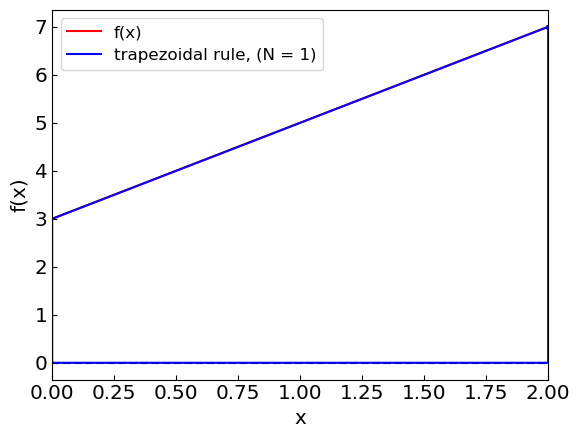
Simpson’s rule#
Derivation#
Recall the error estimate for rectangle and trapezoidal rules:
and
Simpson’s rule is a combination of rectangle and trapezoidal rules:
This combination is chosen such that \(O[(b-a)^3]\) error term vanishes. Another way to derive Simpson’s rule is to interpolate the integrand by a quadratic polynomial through the endpoints and the midpoint.
Simpson’s rule reads
Composite Simpson’s rule#
In the composite Simpson’s rule one splits the integration interval into an even number \(N\) of subintervals. With \(h = (b-a)/N\) one has
with
Implementation#
# Simpson's rule for numerical integration
# of function f(x) over (a,b) using n subintervals
def simpson_rule(f, a, b, n):
if n % 2 == 1:
raise ValueError("Number of subintervals must be even for Simpson's rule.")
h = (b - a) / n
ret = f(a) + f(b)
for k in range(1, n, 2):
xk = a + k * h
ret += 4 * f(xk)
for k in range(2, n-1, 2):
xk = a + k * h
ret += 2 * f(xk)
ret *= h / 3.0
return ret
Illustration#
a = 0.
b = 2.
print("Computing the integral of",flabel, "over the interval (",a,",",b,") using Simpson's rule")
for n in range(2,15,2):
print("N =",n,", I = ",simpson_rule(f,a,b,n))
Computing the integral of x^4 - 2x + 2 over the interval ( 0.0 , 2.0 ) using Simpson's rule
N = 2 , I = 6.666666666666666
N = 4 , I = 6.416666666666666
N = 6 , I = 6.403292181069957
N = 8 , I = 6.401041666666666
N = 10 , I = 6.400426666666667
N = 12 , I = 6.4002057613168715
N = 14 , I = 6.400111064834095
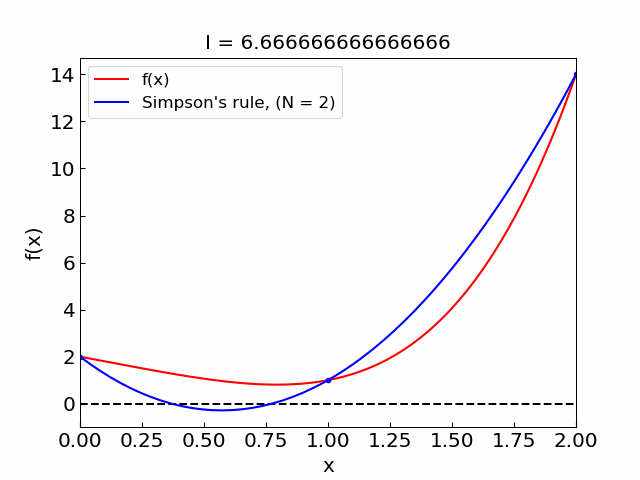
Error#
We can compare Simpson’s rule with rectangle and trapezoidal rules
a = flimit_a
b = flimit_b
print("Computing the integral of",flabel, "over the interval (",a,",",b,") using Simpson's rule")
print("{0:>5} {1:>20} {2:>20} {3:>20}".format("N", "rectangle", "trapezoidal", "Simpson"))
for n in range(2,21,2):
print("{0:5} {1:20.15f} {2:20.15f} {3:20.15f}".format(n, rectangle_rule(f,a,b,n),
trapezoidal_rule(f,a,b,n),
simpson_rule(f,a,b,n)))
Computing the integral of x^4 - 2x + 2 over the interval ( 0.0 , 2.0 ) using Simpson's rule
N rectangle trapezoidal Simpson
2 5.125000000000000 9.000000000000000 6.666666666666666
4 6.070312500000000 7.062500000000000 6.416666666666666
6 6.252572016460903 6.695473251028805 6.403292181069957
8 6.316894531250000 6.566406250000000 6.401041666666666
10 6.346759999999996 6.506559999999999 6.400426666666667
12 6.363007973251031 6.474022633744856 6.400205761316871
14 6.372813411078710 6.454394002498951 6.400111064834095
16 6.379180908203125 6.441650390625000 6.400065104166666
18 6.383547985571311 6.432911649646909 6.400040644210740
20 6.386672500000006 6.426660000000005 6.400026666666668
The error for the Simpson’s rule can be shown to be of order \(h^4\), i.e. $\( I - I_S = C \, h^4 + \mathcal{O}(h^6) \)$
Simpson’s rule is exact for polynomials up to 3rd order
Quadratic integrand#
flabelquad = 'f(x) = 3 * x^2 + x + 3'
def fquad(x):
return 3. * x**2 + x + 3.
a = 0.
b = 2.
print("Computing the integral of",flabelquad, "over the interval (",a,",",b,")")
print("{:<5} {:<20} {:<20}".format("N", "Simpson's rule", "Trapezoidal rule"))
for n in range(2,11,2):
print("{:<5} {:<20.15f} {:<20.15f}".format(n, simpson_rule(fquad,a,b,n), trapezoidal_rule(fquad,a,b,n)))
Computing the integral of f(x) = 3 * x^2 + x + 3 over the interval ( 0.0 , 2.0 )
N Simpson's rule Trapezoidal rule
2 16.000000000000000 17.000000000000000
4 16.000000000000000 16.250000000000000
6 16.000000000000000 16.111111111111107
8 16.000000000000000 16.062500000000000
10 16.000000000000000 16.039999999999999
Cubic integrand#
flabelcubic = 'f(x) = 2*x^3 - 3 * x^2 + x + 3'
def fcubic(x):
return 2. * x**3 - 3. * x**2 + x + 3.
a = 0.
b = 2.
print("Computing the integral of",flabelcubic, "over the interval (",a,",",b,")")
print("{:<5} {:<20} {:<20}".format("N", "Simpson's rule", "Trapezoidal rule"))
for n in range(2,11,2):
print("{:<5} {:<20.15f} {:<20.15f}".format(n, simpson_rule(fcubic,a,b,n), trapezoidal_rule(fcubic,a,b,n)))
Computing the integral of f(x) = 2*x^3 - 3 * x^2 + x + 3 over the interval ( 0.0 , 2.0 )
N Simpson's rule Trapezoidal rule
2 8.000000000000000 9.000000000000000
4 8.000000000000000 8.250000000000000
6 7.999999999999998 8.111111111111109
8 8.000000000000000 8.062500000000000
10 8.000000000000000 8.039999999999999

